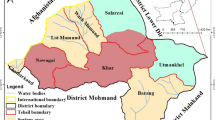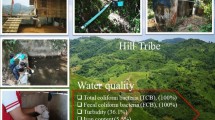Abstract
Water quality surveillance systems are hardly applied in rural contexts. To provide a comprehensive analysis of drinking-water quality in two rural settlements in the Colombian Caribbean drinking-water samples were collected and analyzed from storage containers in 42 homes. The results of physical, chemical, and microbiological analyses of the water samples were compared with values established by the World Health Organization (WHO) Guidelines for Drinking-water Quality, and Colombian regulations. The Kruskal–Wallis test was applied to compare each parameter for supply source, season (rainy or dry), settlement, and types of storage. Drinking-water Quality Risk Index (IRCA) was calculated for each of the samples. The water supply sources were varied: well (33.3%), rainwater (23.8%), artificial pond (23.8%), and river (19.0%). One-hundred percent of the samples contained Escherichia coli and total coliforms. The IRCA varied between 57.3 and 83.9, with a median of 72.9. Eighty-eight percent of the samples exhibited high risk levels (35.1 < IRCA < 80.0) and 12% were unsanitary (80.1 < IRCA < 100.0). Artificial pond water was the source of supply with the worst IRCA (83.79). Drinking water in the El Cascajo and La Delfina settlements does not meet international and national drinking-water standards. A change is required whereby monitoring and quality control policies take into account the reality of rural settings.






Similar content being viewed by others
Data availability
Dataset (Galezzo & Rodríguez, 2020).
Notes
The Drinking-water Quality Control and Protection System only applies to persons or companies that supply or distribute drinking water.
An artificial pond is an open-air deposit for rainwater.
References
Abdul, K. S. M., Jayasinghe, S. S., Chandana, E. P. S., Jayasumana, C., & Silva, P. M. C. S. De. (2015). Arsenic and human health effects: a review. Environmental Toxicology and Pharmacology, 40(3), 828–846. https://doi.org/10.1016/j.etap.2015.09.016
Barragán, J.L. Moncada., Cuesta, Lucumí D.I.., & Susa, M.S. Rodriguez. (2021). Quantitative microbial risk assessment to estimate the public health risk from exposure to enterotoxigenic E. coli in drinking water in the rural area of Villapinzon, Colombia. Microbial Risk Analysis, 100173.
Celis Zapata, L. P. (2013). Análisis de la política pública de agua potable y saneamiento básico para el sector rural en Colombia - período de gobierno 2010 - 2014 [Pontificia Universidad Javeriana]. http://hdl.handle.net/10554/15314
Chang, M., McBroom, M. W., & Scott Beasley, R. (2004). Roofing as a source of nonpoint water pollution. Journal of Environmental Management, 73(4), 307–315. https://doi.org/10.1016/j.jenvman.2004.06.014
Craun, G. F. (2018). Waterborne diseases in the US (G. F. Craun (ed.)). CRC Press. https://doi.org/10.1201/9781351077668
Cuizano, N., & a, Reyes, Ú. F., Domínguez, S., & Llanos, B. P. . (2010). Relevance of the pH on the adsorption of metallic ions by brown seaweeds. Revista Sociedad Química Perú, 76(2), 123–130.
D’Ippoliti, D., Santelli, E., De Sario, M., Scortichini, M., Davoli, M., & Michelozzi, P. (2015). Arsenic in drinking water and mortality for cancer and chronic diseases in Central Italy, 1990–2010. PLoS ONE, 10(9), 1–19. https://doi.org/10.1371/journal.pone.0138182
Domínguez Rivera, I., Oviedo-Ocaña, E. R., & Restrepo-Tarquino, I. (2016). Service provision in rural water supplies: analysis of four community-based systems in Colombia. Cuadernos de Desarrollo Rural, 13(77), 117. https://doi.org/10.11144/Javeriana.cdr13-77.sprw
Efsa. (2010). Scientific opinion on lead in food. In EFSA Journal (Vol. 8, Issue 4, p. 1570). http://www.efsa.europa.eu/en/efsajournal/doc/1570.pdf
Efstratiou, A., Ongerth, J. E., & Karanis, P. (2017). Waterborne transmission of protozoan parasites: review of worldwide outbreaks—an update 2011–2016. Water Research, 114, 14–22. https://doi.org/10.1016/j.watres.2017.01.036
Esrey, S. A., Potash, J. B., Roberts, L., & Shiff, C. (1991). Effects of improved water supply and sanitation on ascariasis, diarrhoea, dracunculiasis, hookworm infection, schistosomiasis, and trachoma. Bulletin of the World Health Organization, 69(5), 609–621. http://www.ncbi.nlm.nih.gov/pubmed/1835675
Fewtrell, L., Kaufmann, R. B., Kay, D., Enanoria, W., Haller, L., & Colford, J. M. (2005). Water, sanitation, and hygiene interventions to reduce diarrhoea in less developed countries: a systematic review and meta-analysis. The Lancet Infectious Diseases, 5(1), 42–52. https://doi.org/10.1016/S1473-3099(04)01253-8
Galezzo, M.-A., & Rodríguez, M. (2020). Dataset of physicochemical and microbiological analysis of drinking water samples in two rural communities of the Colombian Caribbean. https://doi.org/10.17632/8dbhv9hc55.1
Grabow, W. (1996). Waterborne diseases: update on water quality assessment and control. Water SA, 22(2), 193–202. https://journals.co.za/content/waters/22/2/AJA03784738_1884
Ho, K. C., Chow, Y. L., & Yau, J. T. S. (2003). Chemical and microbiological qualities of The East River (Dongjiang) water, with particular reference to drinking water supply in Hong Kong. Chemosphere, 52(9), 1441–1450. https://doi.org/10.1016/S0045-6535(03)00481-8
Howard, G., & Jamie, B. (2003). Domestic water quantity, service level and health (p. 33). WHO.
INS. (2011). Manual de instrucciones para la toma, preservción y transporte de muestras de agua de consumo humano para análisis de laboratorio. Instituto Nacional de Salud. https://www.ins.gov.co/sivicap/Documentacin SIVICAP/2011 Manual toma de muestras agua.pdf
Iwegbue, C. M. A. (2015). Metal concentrations in selected brands of canned fish in Nigeria: estimation of dietary intakes and target hazard quotients. Environmental Monitoring and Assessment, 187(3), 85. https://doi.org/10.1007/s10661-014-4135-5
LeChevallier, M. W., & Norton, W. D. (1992). Examining relationships between particle counts and giardia, cryptosporidium, and turbidity. Journal American Water Works Association, 84(12), 54–60.
Lee, J. Y., Bak, G., & Han, M. (2012). Quality of roof-harvested rainwater—comparison of different roofing materials. Environmental Pollution, 162, 422–429. https://doi.org/10.1016/j.envpol.2011.12.005
Martínez-García, J., Jaramillo-Colorado, B. E., & Fernández-Maestre, R. (2019). Water quality of five rural Caribbean towns in Colombia. Environmental Earth Sciences, 78(18), 575. https://doi.org/10.1007/s12665-019-8580-x
Mkandawire, T., & Banda, E. (2009). Assessment of drinking water quality of Mtopwa village in Bangwe Township. Blantyre. Desalination, 248(2009), 557–561. https://doi.org/10.1016/j.desal.2008.05.101
Mkwate, R. C., Chidya, R. C. G., & Wanda, E. M. M. (2017). Assessment of drinking water quality and rural household water treatment in Balaka District, Malawi. Physics and Chemistry of the Earth, Parts A/B/C, 100(August 2017), 353–362. https://doi.org/10.1016/j.pce.2016.10.006
Monteiro, T. (2018). Situación Actual del ODS-6 en la región Anérica Latina. Planes y acciones. http://www.paho.org/blogs/etras/wp-content/uploads/2018/11/Sesion-S01-c-ODS6-en-ALC-.pdf
Mutemi, S., Hoko, Z., & Makurira, H. (2020). Investigating feasibility of use of bio-sand filters for household water treatment in Epworth, Zimbabwe. Physics and Chemistry of the Earth, Parts A/b/c, 117, 102864. https://doi.org/10.1016/j.pce.2020.102864
Needleman, H. L., Schell, A., Bellinger, D., Leviton, A., & Allred, E. N. (1990). The long-term effects of exposure to low doses of lead in childhood. New England Journal of Medicine, 322(2), 83–88. https://doi.org/10.1056/NEJM199001113220203
Overbo, A., Williams, A. R., Evans, B., Hunter, P. R., & Bartram, J. (2016). On-plot drinking water supplies and health: a systematic review. International Journal of Hygiene and Environmental Health, 219(4–5), 317–330. https://doi.org/10.1016/j.ijheh.2016.04.008
Peckham, S., & Awofeso, N. (2014). Water fluoridation: a critical review of the physiological effects of ingested fluoride as a public health intervention. The Scientific World Journal, 2014, 1–10. https://doi.org/10.1155/2014/293019
Richardson, S., Plewa, M., Wagner, E., Schoeny, R., & DeMarini, D. (2007). Occurrence, genotoxicity, and carcinogenicity of regulated and emerging disinfection by-products in drinking water: a review and roadmap for research. Mutation Research/reviews in Mutation Research, 636(1–3), 178–242. https://doi.org/10.1016/j.mrrev.2007.09.001
Rocher, V., Azimi, S., Gasperi, J., Beuvin, L., Muller, M., Moilleron, R., & Chebbo, G. (2004). Hydrocarbons and metals in atmospheric deposition and roof runoff in Central Paris. Water, Air, and Soil Pollution, 159, 67–86. https://doi.org/10.1023/B:WATE.0000049165.12410.98
Shaheed, A., Orgill, J., Montgomery, M. A., Jeuland, M. A., & Brown, J. (2014). Why “improved” water sources are not always safe. Bulletin of the World Health Organization, 92(4), 283–289. https://doi.org/10.2471/BLT.13.119594
Shields, K. F., Bain, R. E. S., Cronk, R., Wright, J. A., & Bartram, J. (2015). Association of supply type with fecal contamination of source water and household stored drinking water in developing countries: a bivariate meta-analysis. Environmental Health Perspectives, 123(12), 1222–1231. https://doi.org/10.1289/ehp.1409002
Speich, B., Croll, D., Fürst, T., Utzinger, J., & Keiser, J. (2016). Effect of sanitation and water treatment on intestinal protozoa infection: a systematic review and meta-analysis. The Lancet Infectious Diseases, 16(1), 87–99. https://doi.org/10.1016/S1473-3099(15)00349-7
Trevett, A. F., Carter, R. C., & Tyrrel, S. F. (2004). Water quality deterioration: a study of household drinking water quality in rural Honduras. International Journal of Environmental Health Research, 14(4), 273–283. https://doi.org/10.1080/09603120410001725612
Tsitsifli, S., & Kanakoudis, V. (2018). Disinfection impacts to drinking water safety—a review. Proceedings, 2(11), 603. https://doi.org/10.3390/proceedings2110603
United Nations. (2015). The Millenium Development Goals Report (Issue June).
Usman, M. A., Gerber, N., & Pangaribowo, E. H. (2018). Drivers of microbiological quality of household drinking water—a case study in rural Ethiopia. Journal of Water and Health, 16(2), 275–288. https://doi.org/10.2166/wh.2017.069
WHO. (2017). Guidelines for Drinking-water Quality: fourth edition incorporating the first addendum.
Wright, J., Gundry, S., & Conroy, R. (2004). Household drinking water in developing countries: a systematic review of microbiological contamination between source and point-of-use. Tropical Medicine and International Health, 9(1), 106–117. https://doi.org/10.1046/j.1365-3156.2003.01160.x
Wuana, R. A., & Okieimen, F. E. (2014). Heavy metal contamination of water and soil. In E. Asrari (Ed.), Heavy Metal Contamination of Water and Soil (Vol. 2011). Apple Academic Press. https://doi.org/10.1201/b16566
Acknowledgements
We thank the communities of the settlements of El Cascajo and La Delfina who kindly decided to participate in the study. We also thank Melissa Pineda, Yefrail Orozco, and Cristian Núñez, who helped collect samples.
Funding
Financial support was provided by the Government of the Department of Cesar through the Administrative Department of Science, Technology, and Innovation (Colciencias) through Call 681 of 2014.
Author information
Authors and Affiliations
Contributions
MAGM wrote the research proposal, conducted the data analysis, did the field work, interpreted the results, and wrote the initial manuscript. MSRS reviewed and approved the research proposal, results, and conclusion and commented and contributed to drafting the manuscript. All authors read and approved the final manuscript.
Corresponding author
Ethics declarations
Ethics approval
The Research Ethics Committee at Universidad de los Andes approved the study under Act No. 965 of October 30, 2017.
Consent to participate
Informed consent was read out to the respondents before the water samples were collected.
Conflict of interest
The authors declare no competing interests.
Additional information
Publisher's Note
Springer Nature remains neutral with regard to jurisdictional claims in published maps and institutional affiliations.
Highlights
• People in El Cascajo y La Delfina are forced to consume unsafe water due to the lack of supply systems.
• The physicochemical parameters that presented the highest degree of non-compliance with allowable values were turbidity, iron, and lead.
• The presence of Escherichia coli in 100% of samples indicates fecal contamination.
• It is important to evaluate decentralization options of water quality surveillance.
• The colombian government must redesign applicable policies for drinking water monitoring and control in rural areas.
Rights and permissions
About this article
Cite this article
Galezzo, MA., Rodríguez Susa, M. The challenges of monitoring and controlling drinking-water quality in dispersed rural areas: a case study based on two settlements in the Colombian Caribbean. Environ Monit Assess 193, 373 (2021). https://doi.org/10.1007/s10661-021-09138-3
Received:
Accepted:
Published:
DOI: https://doi.org/10.1007/s10661-021-09138-3




